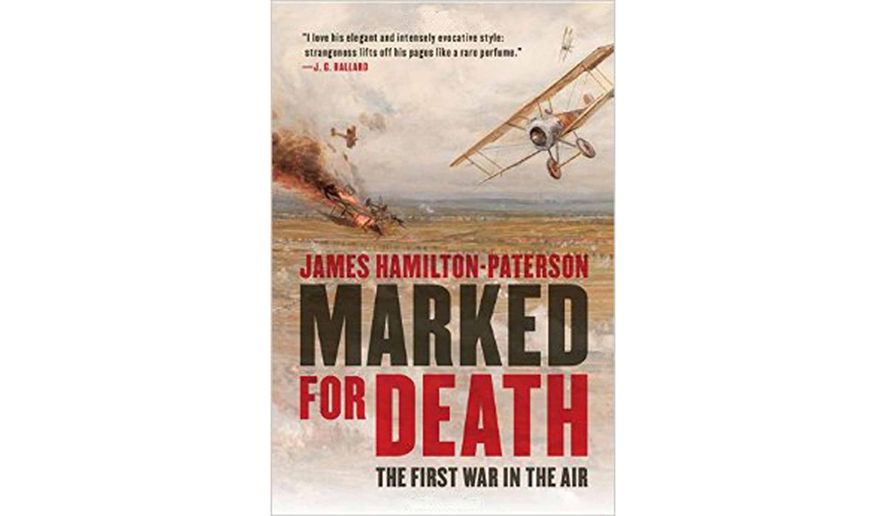OPINION:
MARKED FOR DEATH: THE FIRST WAR IN THE AIR
By James Hamilton-Paterson
Pegasus Books, $27.99, 384 pages
Early in the history of military aviation, the Dutch aircraft designer and pilot Anthony Fokker famously remarked, “Every man who went aloft was marked for death, sooner or later, once his wheels had left the ground.”
Such a somber warning perhaps should have cast a pall on the future of aerial warfare. Further, the mere mention of aircraft in combat brought scorn from Britain’s military leadership. Field Marshall Sir William Nicholson, chief of the Imperial General Staff, declared, “Aviation is a useless and expensive fad advocated by a few individuals whose ideas are unworthy of attention.” And Sir Douglas Haig, soon to be the commander of British Troops in World War I, asserted, “Flying can never be of any use to the army,”
Those skepticisms seemed justified when war erupted in August 1914. Engines were weak, and weight so critical that a pilot’s chances of getting off the ground were reduced “simply by donning a heavy sheepskin flying coat.” Speeds were 50 to 60 miles an hour; indeed, a good headwind could cause a plane to fly backward relative to the ground. “Most existing aircraft could scarcely lift the deadweight of a gun and ammunition …” One early plane had a gunner perched in a crude wooden box in front of the propeller, his head only inches from the swirling blade.
Luckily, there were swift improvements. Within four years, both adversaries boasted planes that could climb to 20,000 feet and fly at more than 200 mph in a dive, reaching g-forces “that could have reduced earlier models to instant firewood.” One important invention was a synchronized machine gun able to fire through the propeller arc (first developed by Germany, followed quickly by Britain).
Mr. Hamilton-Paterson has written extensively on British aviation, and his supremely readable book deals with the development of what was then called the Royal Flight Corps. Armies used gas balloons for reconnaissance during the American Civil War and the Franco-Prussian War of the 1800s. According to another British historian, Richard Overy, in his book “The Bombers and The Bombed,” the first aerial bomb — a modified grenade fashioned by Bulgarian army captain Simon Petrov — was dropped on a Turkish rail station in October 1912 during a war between the Balkan League and Turkey.
As Mr. Hamilton-Paterson writes, the concept of aerial combat quickly achieved a firm grip on public imagination — a “throwback to a ‘cleaner’ sort of war: gladiatorial, personal, even romantic,” a vivid contrast to trench fighting.
Newspapers gave glowing accounts of such “aces” as the German “Red Baron,” Manfred von Richthofen, 54 of whose 80 victims were shot down in flames.
(Mr. Hamilton-Paterson finds it unseemly that the mythology lives on via the comic-strip dog Snoopy, who sits on his kennel pretending to fight the German ace. Reality, he writes, a young Brit was the victim of Richthofen, “his flying gear soaked in petrol, wrapped in flames from 8,000 feet, trailing smoke and screaming for the thirty-odd seconds it took him to hit the ground.”
By his estimate, some 50,000 aircrew (from both sides) died in the war, including training and accidents. As he writes, “airmen shared with the infantry an identical 70 percent chance of injury or death.”
Several men who were brave to the point of recklessness gave aviation significant boosts. Consider Noel Pemberton Billing, a strapping (six feet four inches) eccentric who learned of a German Zeppelin balloon facility near the French border. Wearing civilian clothes “that would have got him shot as a spy had he been caught,” Billing reconnoitered the sheds to plan a raid. Three aircraft were crated and shipped by ferry and truck to France, reassembled and each outfitted with four twenty-pound bombs. As Mr. Hamilton-Paterson writes, “a new hydrogen plant the Germans had just built disappeared in a huge fireball “
Mr. Hamilton-Paterson, an Australian, is an expert on British aviation. He concedes that aviation in the vast conflict was “little more than a highly visible sideshow” and had limited influence in the war’s outcome. But after four years, as technology developed, “aviation was clearly going to change the nature of warfare and ensure its own future.”
• Joseph C. Goulden is the author of 19 nonfiction books.




Please read our comment policy before commenting.